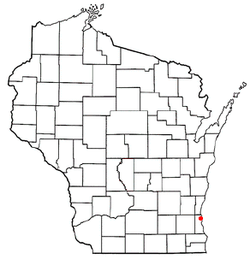Whitefish Bay National Guard Armory
|
Whitefish Bay National Guard Armory | |
 | |
| Location |
1225 E. Henry Clay St. Whitefish Bay, Wisconsin |
|---|---|
| Architect | Herbert Tullgren |
| NRHP Reference # | 02000650 |
| Added to NRHP | June 6, 2002 |
The Whitefish Bay National Guard Armory was located in Whitefish Bay, Wisconsin on the southwest corner of Henry Clay St. and Ardmore Ave. on 6 acres (24,000 m2) of land. The red brick fortress-like building with a crenelated top and central tower was designed by noted architect Herbert Tullgren and thought to be the "finest armory in the state". Inside were well-lit classrooms off of wide terrazo corridors, a double staircase with an ornate ogee window, a big gymnasium, a good kitchen, and a lounge with a beamed ceiling and a mammoth fireplace.
National Register
It was placed on the National Register of Historic Places in 2002, because it was considered historically significant. Many village events were held in the armory over the years, and because many Milwaukeeans in units of the Wisconsin National Guard trained there for duty for World War II and the Korean War. The Whitefish Bay National Guard Armory had also been named a Milwaukee County Landmark in 1989.[1] The 19-acre (77,000 m2) plot of land bordered by Henry Clay Street on the north, Ardmore Avenue on the east, Marlborough Drive and Kimbark Place on the west and Farmount Avenue on the south was purchased in 1870 by German immigrant, Gustave Raab, who built a white frame farmhouse for his wife and two daughters.
Well after his death, in the late 19th century the property was purchased by Otto Falk, vice-president of Falk corporation and a prominent officer in the Wisconsin National Guard, and used by an artillery unit of the National Guard for a summer camp as early as 1909. Through the years the farmhouse was occupied by three different commanding officers and their families. National Guard soldiers trained on this property for duty in the Mexican border war and World War I, and became part of the famed and decorated 32nd Red Arrow Division. Prior to 1929 the southern most 13 acres (53,000 m2) were sold to the village of Whitefish Bay to be used for the new high school, also designed by Tullgren In 1941 red brick garages were added to west side of the Armory and a two story addition to the farmhouse provided offices and a classroom and in the basement, a pine-paneled officers' club room. It was affectionately dubbed the "Whitehouse".
Village Purchase
After the Village of Whitefish Bay bought the property in 1995 for $475,000, a number of public hearings were held on how the building should be used. Many suggestions were submitted including condos, a hockey rink, a swimming pool and a community center/multi-use building. All were rejected by the village board with no in-depth consideration. In January 1998, the decision was made to raze the building, its garages and a small farmhouse for use as a park. In 1999, area resident Janice Collins began a crusade to save the farmhouse, one of the oldest buildings in the village. Soon after that, another resident, Janet Melamed, organized an effort, Save The Armory Trust, Inc, to save the larger building. Several of those who spoke before a village board meeting advocated renovating the armory for use by the library. This idea eventually was also not accepted.
However, the armory garages were fortunately available to be converted into a necessary temporary village library, while a new building was constructed. When the new building was completed, the armory was once again abandoned except for two rummage sales and an exhibit of school art work sponsored by STAT. The building was finally demolished in 2004. The site is now known as Armory Park.
References
http://www.youtube.com/watch?v=kNmgwnLdT48